Providence. The far western Seychelles. As remote as it gets. 438 miles south-west of the capital, Mahe and about a million miles from anywhere. This wild and stunningly beautiful atoll was first discovered in 1501 by Portuguese explorer Joao da Nova, and it is just about as pristine now as it was five hundred long year ago.
BY MATT HARRIS – www.mattharrisflyfishing.com

The sun was sinking low as my friend and guide Wesley De Klerk scanned the horizon. The light was fading, and peering into the water of the flats was becoming increasingly difficult. Apart from a big curious guitar shark that ambled off to our left, the endless flats seemed uncharacteristically devoid of life.
It was the last hour of the last day, and as a big grey cloud rolled in front of the sun it was looking like our quest for a “Seychelles Slam” was going to end in failure after all.
I had no right to complain. We’d had a good day. A great day. I’d wrestled three big brutish Giant Trevally off of the wild flats, and also managed to fool a gorgeous yellow margin triggerfish into snaffling my crab fly. Yet the bonefish – normally the easiest part of any slam – had eluded us.
In truth, perhaps we’d cut things just a little too fine. The trevally action had been irresistible, and had kept us busy late into the afternoon. Our trip from Cerf Island in the South, up to the north end of the atoll to the wide shallow flats where the big Providence bonefish like to grub for crabs and mantis shrimps is a long one.
By the time we’d arrived, the sun was already low in the sky, and now, the clouds crowding the horizon threatened to destroy what chance we had.

Then, suddenly, just as I was contemplating throwing in the towel and winding up, a last golden shaft of light pierced the big thunderhead gathering way off to the West.
The flats lit up, and Wesley was instantly galvanised. The tide had turned, and in the low golden light, hazy, indistinct shapes were suddenly visible in the knee-deep water.
“There,” hissed Wesley, “ten o’clock, twenty metres going left”
I saw it – a big singleton bonefish – but moving fast and going away – perhaps already spooked.
Wesley and I had argued about fly choice – earlier in the week, my pal Dom Quinlan had given me an absurdly garish bright orange flexo-crab fly tied for him by master tyer Jonno Makim, and despite my skepticism, the fly had proved utterly irresistible to bonefish and triggers alike.
Wesley wasn’t convinced and wanted to try something more orthodox and more subtle, but I had huge confidence in what had gained notoriety on the mothership as the “Tandoori Crab”, and stubbornly stuck with my talisman.
It was a tough shot, into a stiff breeze, but I pitched the fly well beyond the fish and just to its left. As it landed, I felt a surge of confidence. It was a good presentation and the fish would surely eat it. But no.
My prize sidled away, without giving my offering so much as a cursory glance.
I heard a barely suppressed groan from behind me and felt Wesley’s frustration – it’s always a big call to ignore your guide’s instincts. Especially when they are as experienced and as talented as Wesley.
I stripped the fly back – perhaps we might get one last chance and I decided to do the right thing, and swap to Wesley’s suggested classic Gotcha pattern. However, even as I retrieved the fly, Wes was calling another shot: there, thirty yards to my left, two barely discernable shadows were zig-zagging across the flat towards us.
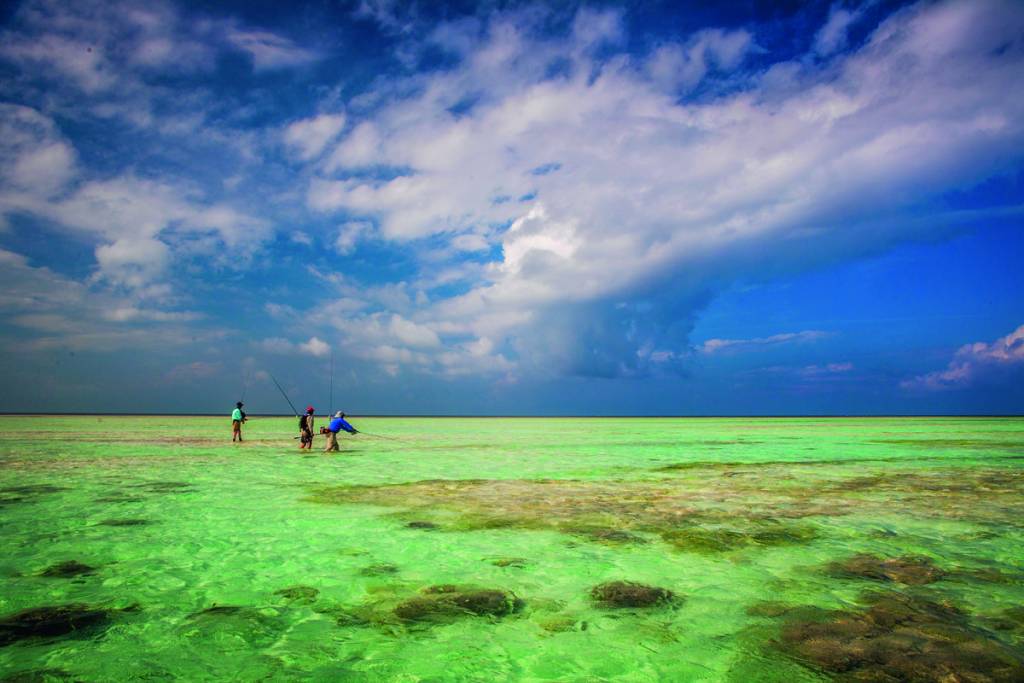
No time to change. I lengthened the line – good shot – the crab landed gently just ahead of the lead fish.
There is something extremely special about fishing for bonefish. The simple stripped-down visual thrill of watching them accelerate in ultra-shallow water, and seeing them tip up to eat the fly is – and will always be – one of the great sights in saltwater fly-fishing.
The lead fish shot forward, and its tail broke the surface. I knew instinctively that it had inhaled the fly.
I strip-set the hook and the line sizzled off of the reel as the bonefish made its signature lightning dash across the wide white flats, throwing up a roostertail of spray that sparkled in the last guttering rays of sunshine.
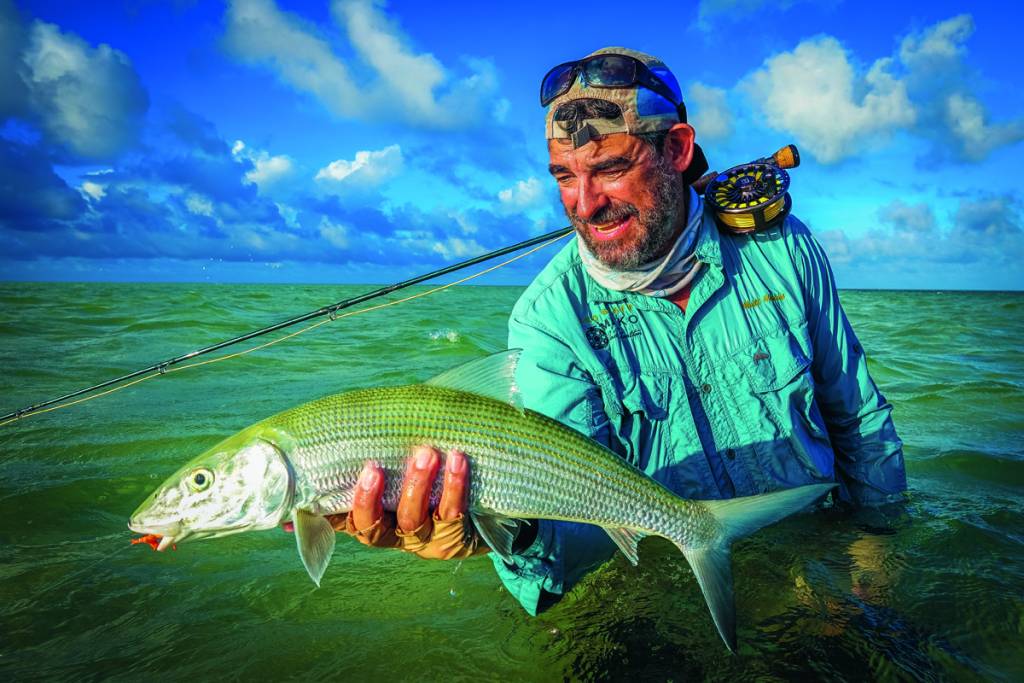
There are fewer bigger kicks in fly-fishing than completing a Grand Slam, and at Providence, there are any number of ways to do it. One way is a GT, a trigger and a bone, and closing the deal would make for the perfect end to the trip.
I played my prize with exaggerated care, but finally, Wesley had the fish in his grasp – one last dazzling silver Providence bonefish to end the week on a high.
A few quick pictures and then high fives spluttered laughter, and cold Seybrew beers in the dying embers of a special day.
I first came to Providence in 2007. Back then, it had barely seen a fly-fisherman. Just as I arrived in Mahe, the Seychelles’ capital, a powerful cyclone had all but flattened the outlying island, and we spent three frustrating days in the capital, waiting to fly out. Finally we got the all-clear, but when we arrived at Farquar, the base used as the starting point for the long sail to Providence, the sea looked treacherous and forbidding. The long trip by boat was a torrid crossing. We battled through a savage storm, replete with St Elmo’s fire on the metal masts of our big schooner, but finally, our ordeal was over. Was it worth it? You bet. What a place we found when we finally arrived.
“Triggers are tricky customers and are not always easy to fool”.
Providence was a fly-fishing wonderland. It had – and still has – just about everything.
The wide sand flats on the northeast side of the atoll are rich, abundant feeding grounds, and when the tide starts to rise, big, lithe indo-pacific bonefish (Albula glossodonta) come ghosting onto this broad white canvas. While many – including myself – often get fixated on chasing the bigger, more exotic species of the atoll, the bonefishing here is simply superlative.
The fish are of an excellent average size, with a bona fide ten pound fish a genuine possibility. On the pristine and unblemished white sand, fish can be spotted from vast distances, and hunting them down is immensely absorbing. It is some of the very best bonefishing that I have ever experienced.
The bones don’t have the shallow flats all to themselves. Three distinct species of triggerfish forage around the skirts and drop-offs, ferreting out crabs and demolishing them in short order with their formidable dentistry. Be warned.
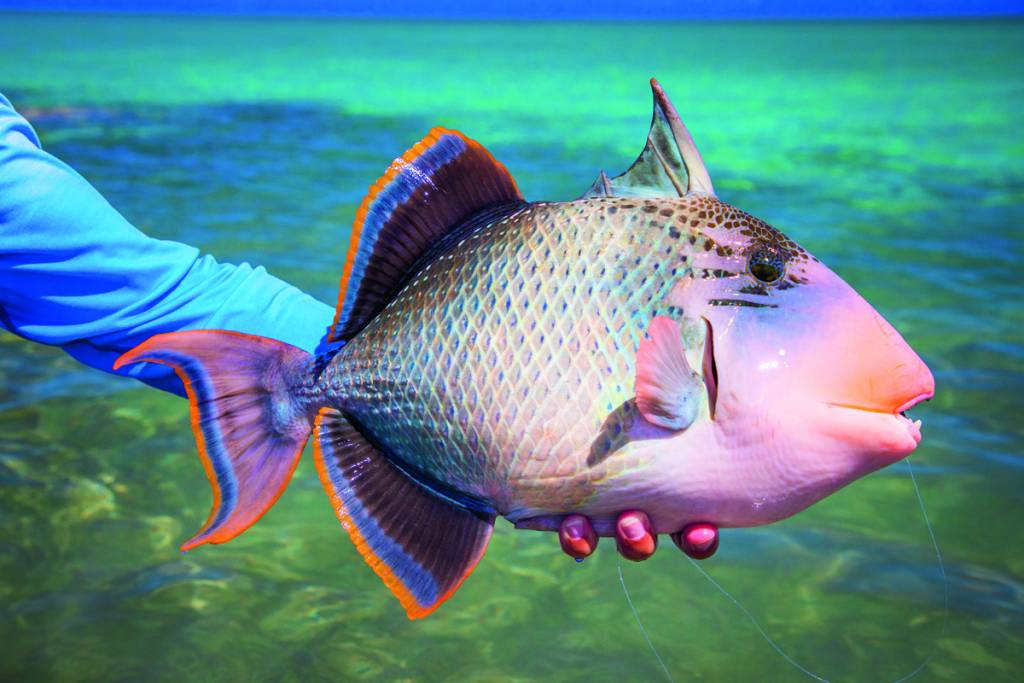
Triggers are tricky customers and are not always easy to fool. They are often dubbed as “Permit Light”, by the guides, and catching one takes guile and cunning.
These wonderful fly rod adversaries are remarkable in that they can swim backwards. Watching them approach a fly before backing off nervously and then – if you’re lucky – coming back for a second look, is one of the most addictive and intriguing challenges on the Providence flats.
Hooking them is the easy part – keeping them away from all that leader-shredding coral is no mean feat, and even then, there’s every chance that they may just bite your premium forged steel hook clean in half.
The main triggerfish targets are the Yellow Margin ( Pseudobalistes flavimarginatus) and the Titan, Giant or Moustache triggerfish (Balistoides viridescens), both of which populate the Providence flats in numbers. However, perhaps the most bewitching of all is their little cousin, the Picasso triggerfish (Rhinecanthus aculeatus).
This stunning little work of art is – to my mind at least – infinitely more beautiful than anything its genius namesake ever conjured up. If you find one foraging around a coral head, scale down to a tiny fleeing crab pattern and, if you can manage to dupe it, take time out to simply admire this breathtaking little jewel of a creature.
Another remarkable fish to call Providence home is the Bumphead Parrotfish.
(Bolbometopon muricatum) These enormous hulking freaks amble around the flats, using their powerful beaks to feed on algae-covered corals. A big school can make short work of a small reef, and contribute to the natural but significant bio-erosion of the ocean’s corals.
Creeping up to a feeding school is fascinating. If you are stealthy enough, you can get very close, and watching a large school of these big brutes placidly grazing on the coral like a herd of cows is spellbinding. Tie on a small Velcro coin-crab and pitch it very accurately in front of your chosen target. If your shot is a good one, you may be in for an astonishing hour-long tussle with one of these curious but deceptively powerful creatures, which can range to an eye-watering 100 pounds and more.

Off the edge of the flats, the celebrated milkfish ( Chanos chanos ) offers another exceptionally exciting target. When the wind drops away, these fish will school up and feed on the floating rafts of algae hovering in the upper strata of the water column. Dead drifting a “milky dream” algae representation into their midst can often lead to an epic battle with one of these fish. Chanos chanos are reputed to be the only species that do not suffer from lactic acid build-up, and thus seem never to tire. This is another species that – once hooked – can gobble up a large but unforgettable part of your day.
Indo-Pacific Permit (Trachinotus blochii) are scarce but do occasionally make a showing, and they are perhaps the toughest target on the Providence flats – every bit as tricky to tempt as their Caribbean cousins. In recent years, James Christmas’s brilliant sand prawn, and the cunningly conceived Alphlexo Crab pattern have made these fish just slightly easier to dupe. Just slightly.
They are still infuriatingly capricious, and refuse even the most perfect presentation with depressing regularity. Catching one entitles you to a mile-wide smile, safe in the knowledge that you will be “belle of the ball” on the mothership tonight.
“Beg, borrow or steal your way to this magical fishery“
A bewildering and vibrant kaleidoscope of other species all compete for your attention on Providence’s vast flats and drop-offs – stunningly beautiful Bluefin Trevally, big Maori Wrasse, monster Barracuda, and any number of spectacularly colourful grouper and snapper, not to mention big pelagic brutes like sailfish and wahoo, lurking just a few hundred metres beyond the drop-off.
However, undoubtedly the biggest draw is Caranx Ignobilis – the Giant Trevally – big brawny hoodlums that maraud onto the flats, charging down a well-presented fly with primal aggression that just never gets old. Tackling GTs is not for the faint of heart – these apex bruisers will head for the nearest coral head every time, so do up your drag and hold on tight. The first few seconds of the fight is one of the most exhilarating moments in all of fly-fishing. You will simply never forget the first time that your fly line rockets up out of the water, and your big saltwater reel starts to shriek in protest as that big powerful brute goes bulldozing off across the flats looking for something sharp on which to break your leader and your heart.
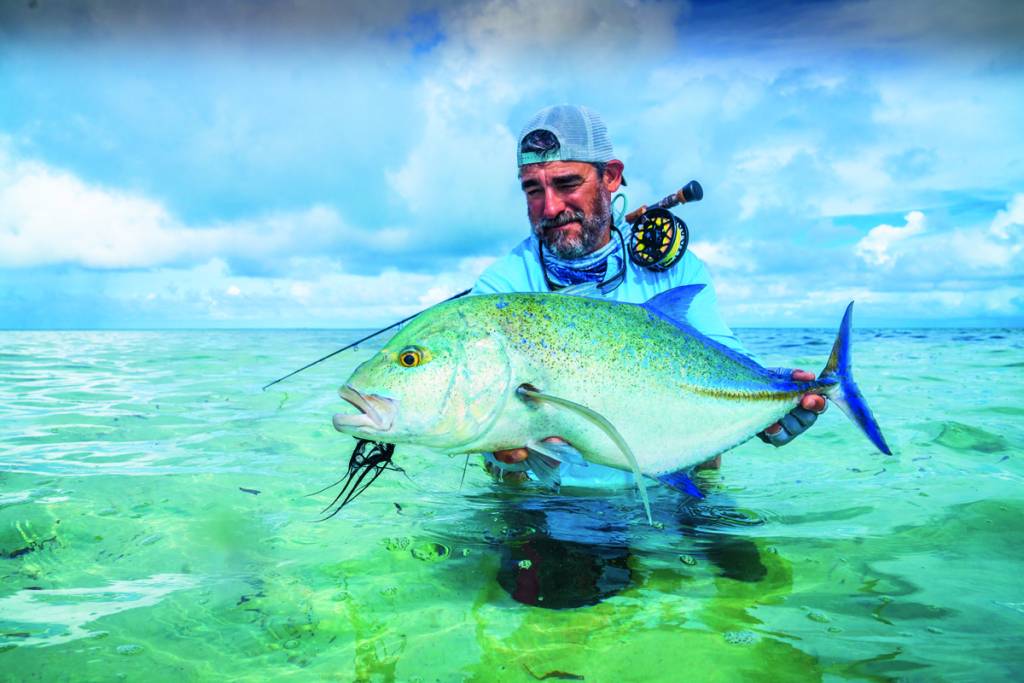

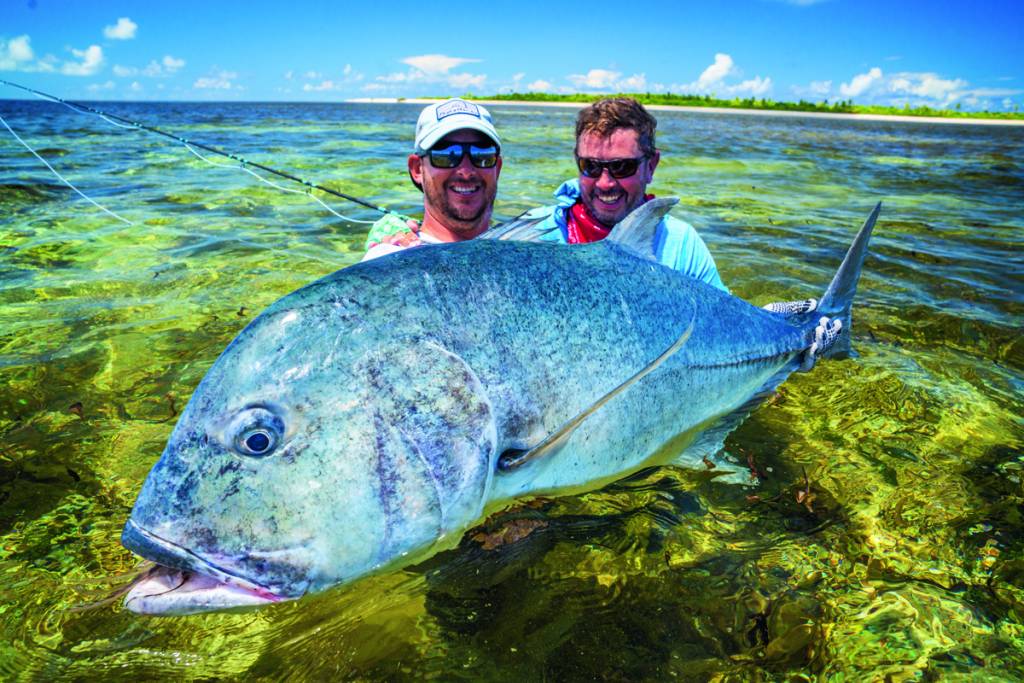

Protect your rod by leaning into the fish with the butt of your twelve weight rod, and pull as hard as you dare. Landing your first Giant Trevally is an unforgettable thrill, but for the novice, the violence and power of these fish can be almost frightening. If its your first ‘Caranx’ then remember not to “high-stick” the rod, and in the heat of battle, pay special attention to the advice of your guide. The Providence guides have caught hundreds of these incredibly powerful fish, and they know exactly what to do. Put your trust in them, and you should soon be holding up your first GT for a quick picture. While many believe that a true GIANT Trevally has to be over a metre long, every one is precious. Enjoy them all, and handle them with the care and respect they deserve.
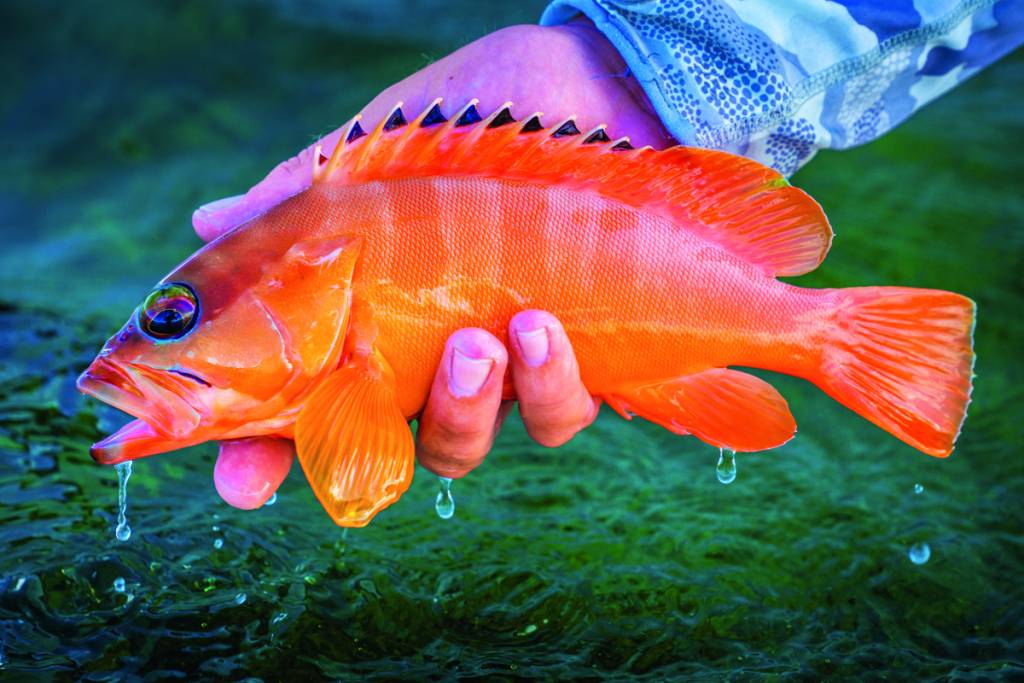
In truth, it is impossible to describe the endless thrills and spills that Providence can offer in a few short words. However, rest assured that Tim Babich, Wesley de Klerk, Brendan Becker, Nic Isabelle and all the excellent and hugely likeable Flycastaway guides that know and love this little corner of paradise will show you fishing that is as exhilarating as it is varied.
If you love to fly fish in salt water, do what you have to: beg, borrow or steal your way to this magical fishery. As you first step onto the hard sand flats take a few moments to simply enjoy the unsullied beauty of this beguiling tropical wilderness.
Ok, snap out of it…now comes the hard part: trying to figure out what you want to catch first.
Contact:
Matt Harris has been fishing and photographing the Seychelles’ magical fisheries since 2006.
As well as Providence, Matt has fished all of the other celebrated destination atolls in the Seychelles: Alphonse, Astove, Farquar and Cosmoledo. Matt knows each of these destinations well and can tell you exactly what each has to offer. If you are interested in joining him on a trip to one of these special fisheries, contact him at mattharris@mattharris.com
You can read all about fishing these and many other amazing destinations in Matt’s new book “The Fish of a Lifetime” via the link at http://www.thefishofalifetime.com







